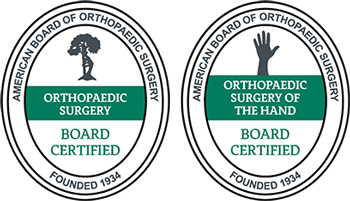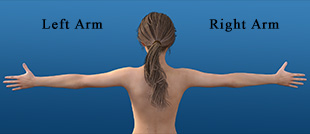How Can I Tell If I have Mallet or Trigger Finger?
You probably use your hands daily without pausing to appreciate their true value in your routine tasks. A condition such as mallet finger or trigger finger can cause you to suddenly realize just how essential finger dexterity and comfortable hand movement are. If you’re unable to extend one or more of your fingers fully, one of these conditions may lie at the root of your problem. Understanding the differences between mallet finger and trigger finger will help you pinpoint what is causing your troubles.
Contents
Understand These Conditions
Mallet finger and trigger finger both affect the fingers and hands, resulting in pain and tenderness. However, the similarities end there. Mallet finger and trigger finger are markedly different, making it relatively easy to tell them apart once you understand what they are.
Mallet finger occurs when you sustain a blunt force at the tip of your finger. The condition typically results from heavy impact, such as from a baseball. However, mallet finger can result from something as simple as tucking in a bed sheet with too much force. Regardless of the cause, the extensor tendon on the top of the finger either ruptures or pulls away from the bone. The tendon may also take a small piece of bone away with it. With the tendon detached, the fingertip can no longer extend.
Trigger finger is a more complex condition that affects the A1 pulley. The A1 pulley helps secure the flexor tendon to the bone at the finger’s base. You may experience trigger finger if the A1 pulley becomes inflamed or thickened, making it difficult for the flexor tendon to pass through this narrow tunnel. The flexor tendon, in turn, may also become inflamed and develop a small nodule. When this nodule passes through the inflamed A1 pulley, it can make a clicking noise or create an uncomfortable sensation.
Assess the Symptoms
Evaluating your symptoms will help determine whether you’re suffering from mallet or trigger finger. Though both conditions make it difficult to straighten the finger, one causes the fingertip to droop gently, while the other causes the finger to lock rigidly into a bent position.
The most common symptoms of mallet finger include:
- Drooping at the fingertip.
- The inability to straighten the fingertip.
- Tenderness along the finger.
- Swelling, bruising, and redness on the finger.
- Redness beneath the fingernail bed.
- A detached fingernail.
It’s important to note that bruising or discoloration around the fingernail can indicate a penetrating injury that extends from a cut in the nail bed down to the open fracture. A detached fingernail may indicate the same thing. You should seek immediate medical treatment if you notice these symptoms, as you have an increased risk for infection that a physician must treat right away.
Trigger finger has some similarities, but many primary symptoms differ quite noticeably. Common signs of trigger finger include:
- Stiffness of the finger, especially in the morning.
- A bump or tender spot at the base of the affected finger.
- Clicking or popping when you bend the finger.
- Difficulty straightening the finger.
- A sensation that the finger is locked into a bent position.
Both trigger finger and mallet finger can affect any finger on the hand and may even impact more than one finger at a time.
Consider Your Risk Factors
Mallet finger occurs as the result of an injury. Consider whether you’ve recently sustained a painful injury to your hand. If you slammed your finger in a door, injured it in sports, jammed it in a fall, or otherwise sustained a similar impact, it’s more likely that you have mallet finger.
The cause of trigger finger is less obvious, as it typically does not result from an injury. However, participating in activities that require a repeated pinching motion may increase your risk of developing trigger finger. You’re more likely to experience trigger finger if you have rheumatoid arthritis or diabetes.
Consult a Physician
The only sure way to determine whether you have mallet finger or trigger finger is to see a trained physician. Your doctor will begin with a physical examination. To check for mallet finger, your doctor will ask you to straighten your finger, lifting the tip. If you cannot straighten the affected finger without assistance, your physician will likely order an X-ray to confirm the diagnosis. The X-ray will show whether the tendon has ruptured or pulled away with a bone fragment attached.
If you have trigger finger, the doctor may notice swelling and tenderness around the tendon sheath. The doctor might straighten and bend your finger to check it for the signature clicking or popping that often accompanies trigger finger.
Splinting is a common nonsurgical treatment option for both trigger finger and mallet finger. Your doctor may suggest nonsteroidal anti-inflammatory drugs (NSAIDs) to help minimize inflammation and control pain as these conditions heal. Trigger finger may also respond to steroid injections.
If splinting does not resolve the issue, your physician may choose a surgical treatment option. Patients with mallet finger may also suffer from fractures in the finger. A surgeon can repair these fractures using pins to hold the bones together as they heal and can also graft tendon tissue onto the damaged tendon in the finger to help repair the damage caused by mallet finger.
When splinting does not heal trigger finger, physicians typically proceed with surgical treatment to release the A1 pulley. By cutting this pulley, the surgeon releases the tension preventing the finger from properly straightening.
If you’re suffering from an uncomfortable hand condition, you should seek treatment as soon as possible. Properly addressing the issue is the first step toward a timely recovery. Our staff at The Hand and Wrist Institute specializes in hand injuries and conditions, offering both surgical and nonsurgical treatment options. If you’re experiencing pain, discomfort, or difficulty with daily tasks, contact us for an appointment to properly diagnose your condition and develop a personalized treatment plan to help you get back to your regularly scheduled activities.
Image by Adrien King is licensed with Unsplash License


























